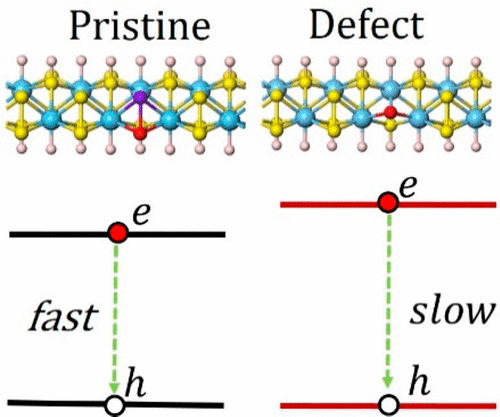当前位置:
X-MOL 学术
›
J. Phys. Chem. Lett.
›
论文详情
Our official English website, www.x-mol.net, welcomes your
feedback! (Note: you will need to create a separate account there.)
Defects Slow Down Nonradiative Electron–Hole Recombination in TiS3 Nanoribbons: A Time-Domain Ab Initio Study
The Journal of Physical Chemistry Letters ( IF 4.8 ) Pub Date : 2017-09-08 00:00:00 , DOI: 10.1021/acs.jpclett.7b02099 Yaqing Wei 1 , Zhaohui Zhou 2 , Run Long 1
The Journal of Physical Chemistry Letters ( IF 4.8 ) Pub Date : 2017-09-08 00:00:00 , DOI: 10.1021/acs.jpclett.7b02099 Yaqing Wei 1 , Zhaohui Zhou 2 , Run Long 1
Affiliation

|
Layered TiS3 materials hold appealing potential in photovoltaics and optoelectronics due to their excellent electronic and optical properties. Using time domain density functional theory combined with nonadiabatic (NA) molecular dynamics, we show that the electron–hole recombination in pristine TiS3 nanoribbons (NRs) occurs in tens of picoseconds and is over 10-fold faster than the experimental value. By performing an atomistic ab initio simulation with a sulfur vacancy, we demonstrate that a sulfur vacancy greatly reduces electron–hole recombination, achieving good agreement with experiment. Introduction of a sulfur vacancy increases the band gap slightly because the NR’s highest occupied molecular orbital is lowered in energy. More importantly, the sulfur vacancy partially diminishes the electron and hole wave functions’ overlap and reduces NA electron–phonon coupling, which competes successfully with the longer decoherence time, slowing down recombination. Our study suggests that a rational choice of defects can control nonradiative electron–hole recombination in TiS3 NRs and provides mechanistic principles for photovoltaic and optoelectronic device design.
中文翻译:

TiS 3纳米带中缺陷减慢非辐射电子-空穴复合:时域从头算研究
TiS 3层状材料由于其出色的电子和光学特性,在光伏和光电子领域具有诱人的潜力。结合时域密度泛函理论和非绝热(NA)分子动力学,我们证明了原始TiS 3中的电子-空穴复合纳米带(NRs)发生在数十皮秒内,比实验值快10倍以上。通过对硫空位进行原子性从头算模拟,我们证明了硫空位大大降低了电子-空穴的重组,与实验取得了良好的一致性。硫空位的引入稍微增加了带隙,因为NR的最高占据分子轨道的能量降低了。更重要的是,硫空位部分地减少了电子和空穴波功能的重叠,并减少了NA电子-声子耦合,这与更长的去相干时间成功竞争,从而减慢了重组速度。我们的研究表明,合理选择缺陷可以控制TiS 3中的非辐射电子-空穴复合 NR,并提供了用于光伏和光电设备设计的机械原理。
更新日期:2017-09-08
中文翻译:

TiS 3纳米带中缺陷减慢非辐射电子-空穴复合:时域从头算研究
TiS 3层状材料由于其出色的电子和光学特性,在光伏和光电子领域具有诱人的潜力。结合时域密度泛函理论和非绝热(NA)分子动力学,我们证明了原始TiS 3中的电子-空穴复合纳米带(NRs)发生在数十皮秒内,比实验值快10倍以上。通过对硫空位进行原子性从头算模拟,我们证明了硫空位大大降低了电子-空穴的重组,与实验取得了良好的一致性。硫空位的引入稍微增加了带隙,因为NR的最高占据分子轨道的能量降低了。更重要的是,硫空位部分地减少了电子和空穴波功能的重叠,并减少了NA电子-声子耦合,这与更长的去相干时间成功竞争,从而减慢了重组速度。我们的研究表明,合理选择缺陷可以控制TiS 3中的非辐射电子-空穴复合 NR,并提供了用于光伏和光电设备设计的机械原理。











































 京公网安备 11010802027423号
京公网安备 11010802027423号